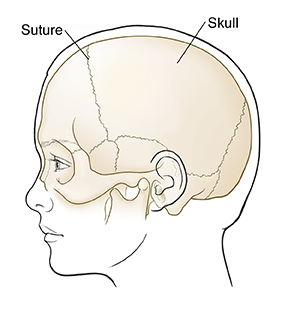Understanding Skull Fracture (Child)
A skull fracture is a type of head injury. It's a break in the bone that surrounds the brain. A skull fracture can occur with or without brain damage.

Types of skull fracture
There are several types of skull fractures:
-
Linear skull fracture. This is a break in the bone, but it doesn't move the bone. This is the most common type. In many case, no treatment is needed. A child can go back to normal activities in a few days.
-
Depressed skull fracture. Part of the skull is sunken in from the injury. If the inner part of the skull is pressed against the brain, this needs treatment right away with surgery.
-
Diastatic skull fracture. This kind of fracture occurs along the suture lines in the skull. These are the areas between the bones in the head that grow together (fuse) as a child grows. With this type of fracture, the suture lines are widened. This type of fracture is more common in newborns and young babies.
-
Basilar skull fracture. This is a break in the bone at the base of the skull. It can be a serious type of skull fracture. Children with this type of fracture often have bruises around their eyes and a bruise behind their ear. They may also have clear fluid draining from their nose or ears. This is because of a tear in part of the covering of the brain.
-
Growing skull fracture. This is a rare complication of diastatic skull fractures. It almost always occurs in children younger than age 3. It's a fracture that becomes wider over time because the brain is rupturing through a gap.
-
Closed fracture. The injury did not break the skin over the fracture. This is the most common.
-
Open fracture. The injury broke the skin over the fracture. This type of injury has a higher risk of infection.
What causes a skull fracture?
The most common causes of skull fracture in children are:
-
Falls
-
Outdoor activities
-
Sports
-
Physical assault
-
Motor vehicle accidents
Boys tend to have traumatic head injuries more often than girls. These kinds of injuries are more common in spring and summer months, when children are active outdoors. Activities, such as bike riding, in-line skating, or skateboarding, can cause injury. Many of these injuries can be prevented by wearing the correct helmet the right way.
Symptoms of a skull fracture
The symptoms of a skull fracture can include:
-
Confusion
-
Trouble with balance
-
Sleepiness
-
Headache
-
Changes in pupil size
-
Bump on the head
-
Bleeding from a head wound
-
Restlessness or irritability
-
Stiff neck
-
Vision changes
-
Slurred speech
-
Nausea and vomiting
-
Loss of consciousness
-
Seizures
-
Bruising behind the ears or under the eyes
-
Clear or bloody fluid draining from ears or nose
The severity of symptoms can vary. They depend on how serious the injury is.
Diagnosing a skull fracture
The healthcare provider will ask about your child’s health history and symptoms. They'll ask about recent accidents or injury. Your child will have a physical and neurological exam. Your child may also have tests, such as:
-
Blood tests. These are done to check for signs of infection and other problems.
-
X-ray. This test uses a small amount of radiation to create images of bones and other parts of the body. It can show a fracture of the skull, but does not show if there is brain injury.
-
MRI scan. This test uses large magnets, radio signals, and a computer to create detailed images of tissues in the body without the use of X-ray.
-
CT scan. This test uses a series of X-rays and a computer to create detailed images of the body. This test can show broken bone, as well as injury to the brain.